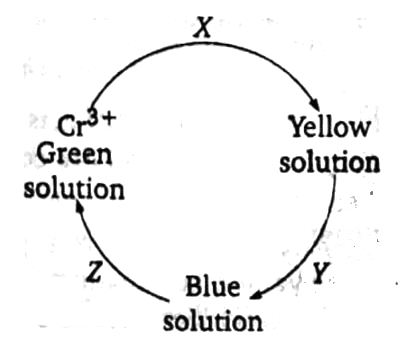A hydrated solid X on heating initally gives a monohydrated compound Y. Y upon heating above 373 K leads to an anhydrous white powder Z, X and Z respectively, are:
Washing soda and Soda ash
Baking soda and dead burnt plaster.
Washing soda and dead burnt plaster
baking soda and soda ash.
The correct Answer is:C
To solve the problem, we need to identify the hydrated solid X and the anhydrous white powder Z based on the information given in the question.
Step 1: Identify the hydrated solid X
The question states that a hydrated solid X on heating gives a monohydrated compound Y. A common example of a hydrated compound is washing soda, which is sodium carbonate decahydrate (Na2CO3·10H2O).
Step 2: Heating X to form Y
When washing soda (Na2CO3·10H2O) is heated, it loses water to form a monohydrated compound Y, which is sodium carbonate monohydrate (Na2CO3·H2O).
Step 3: Heating Y to form Z
Next, the question states that Y (Na2CO3·H2O) upon heating above 373 K leads to an anhydrous white powder Z. When sodium carbonate monohydrate (Na2CO3·H2O) is heated above 373 K, it loses its remaining water and forms anhydrous sodium carbonate (Na2CO3), which is a white powder.
Step 4: Conclusion
Based on the above steps, we can conclude that:
- X is washing soda (Na2CO3·10H2O)
- Z is anhydrous sodium carbonate (Na2CO3)
Final Answer:
X and Z respectively are:
- X: Na2CO3·10H2O (Washing Soda)
- Z: Na2CO3 (Soda Ash)
The question states that a hydrated solid X on heating gives a monohydrated compound Y. A common example of a hydrated compound is washing soda, which is sodium carbonate decahydrate (Na2CO3·10H2O).
When washing soda (Na2CO3·10H2O) is heated, it loses water to form a monohydrated compound Y, which is sodium carbonate monohydrate (Na2CO3·H2O).
Next, the question states that Y (Na2CO3·H2O) upon heating above 373 K leads to an anhydrous white powder Z. When sodium carbonate monohydrate (Na2CO3·H2O) is heated above 373 K, it loses its remaining water and forms anhydrous sodium carbonate (Na2CO3), which is a white powder.
Based on the above steps, we can conclude that:
- X is washing soda (Na2CO3·10H2O)
- Z is anhydrous sodium carbonate (Na2CO3)
X and Z respectively are:
- X: Na2CO3·10H2O (Washing Soda)
- Z: Na2CO3 (Soda Ash)
Topper's Solved these Questions
Similar Questions
Knowledge Check
A white solid X on heating gives a white solid Y and an acid gas Z. gas Z is also given out when X reacts with an acid. The compound Y is also formed if caustic soda is left open in the atmosphere. X, Y and Z are
AX−NaHCO3,Y−Na2CO3,Z−CO2BX−Na2CO3,Y−NaOH,Z−CO2CX−Na2CO3,Y−NaHCO3,Z−CO2DX−NaOH,Y−NaHCO3,Z−CO2A metal X reacts with water to produce a highly combustible gas Y, and a solution Z. another metal P reacts with Z to give the same gas Y. X,Y,Z and P respectively are
AZn,H2,Zn(OH)2,AlBNa,H2,NaOH,ZnCK,H2,KOH,AlDLi,H2,LiOH,K
Reaction of an inorganic sulphite X with dilute H2SO4) generates compound Y . Reaction of Y with NaOH gives X . Further , the reaction of X and Y and water affords compound Z . Y and Z respectively are :
View SolutionAn orange solid (X) on heating, gives a colourless gas (Y) and a only green residue (Z). Gas (Y) on treatment with Mg, produces a white solid substance……
View Solution
X,Y and Z in the above graph are
View SolutionB2H6+NH3→Addition compound (X) 450K−−→ Y+Z(g)
In the above sequence Y and Z are respectively :
View SolutionA colourless water soluble solid (X) on heating gives equimolar quantities of (Y) and (Z). Y gives dense white fumes with HCl and Z does so with NH3. Y gives brown ppt. with K2Hgl4 (Nesslers reagent) and Z gives white precipitate with nitrates of Ag+,Pb2+andHg+. What is X ?
View SolutionA colourless water soluble solid (X) on heating gives equimolar quantities of (Y) and (Z). Y gives dense white fumes with HCl and Z does so with NH3. Y gives brown ppt. with K2HgI4 (Nessler's reagent) and Z gives white precipitate with nitrates of Ag+,Pb2+andHg+. What is X ?
View Solution

